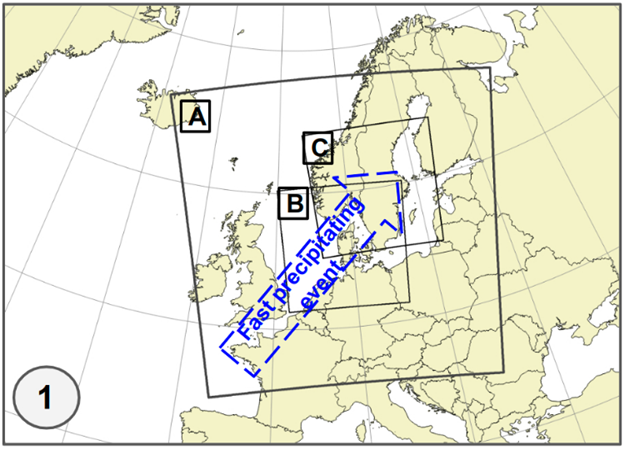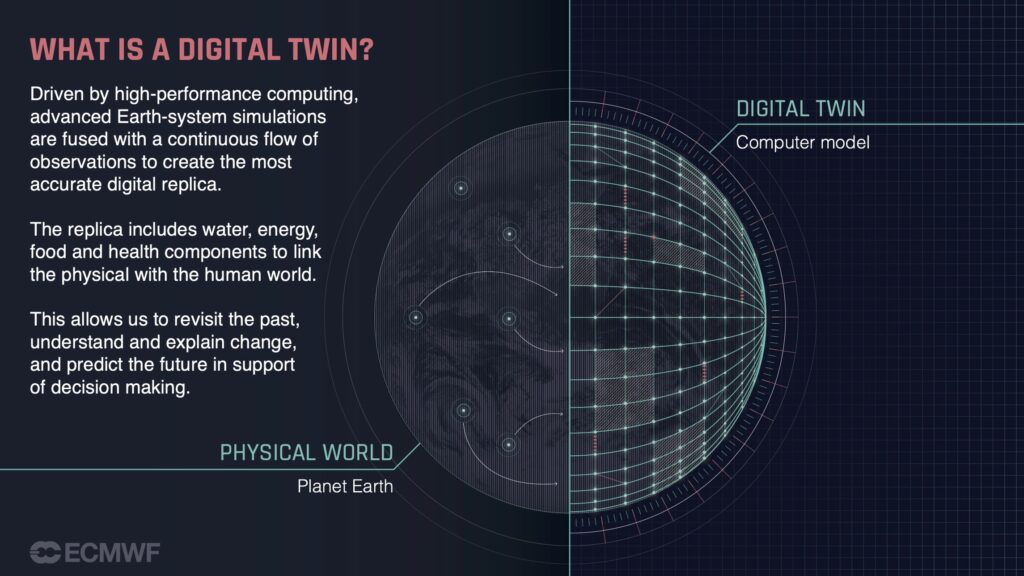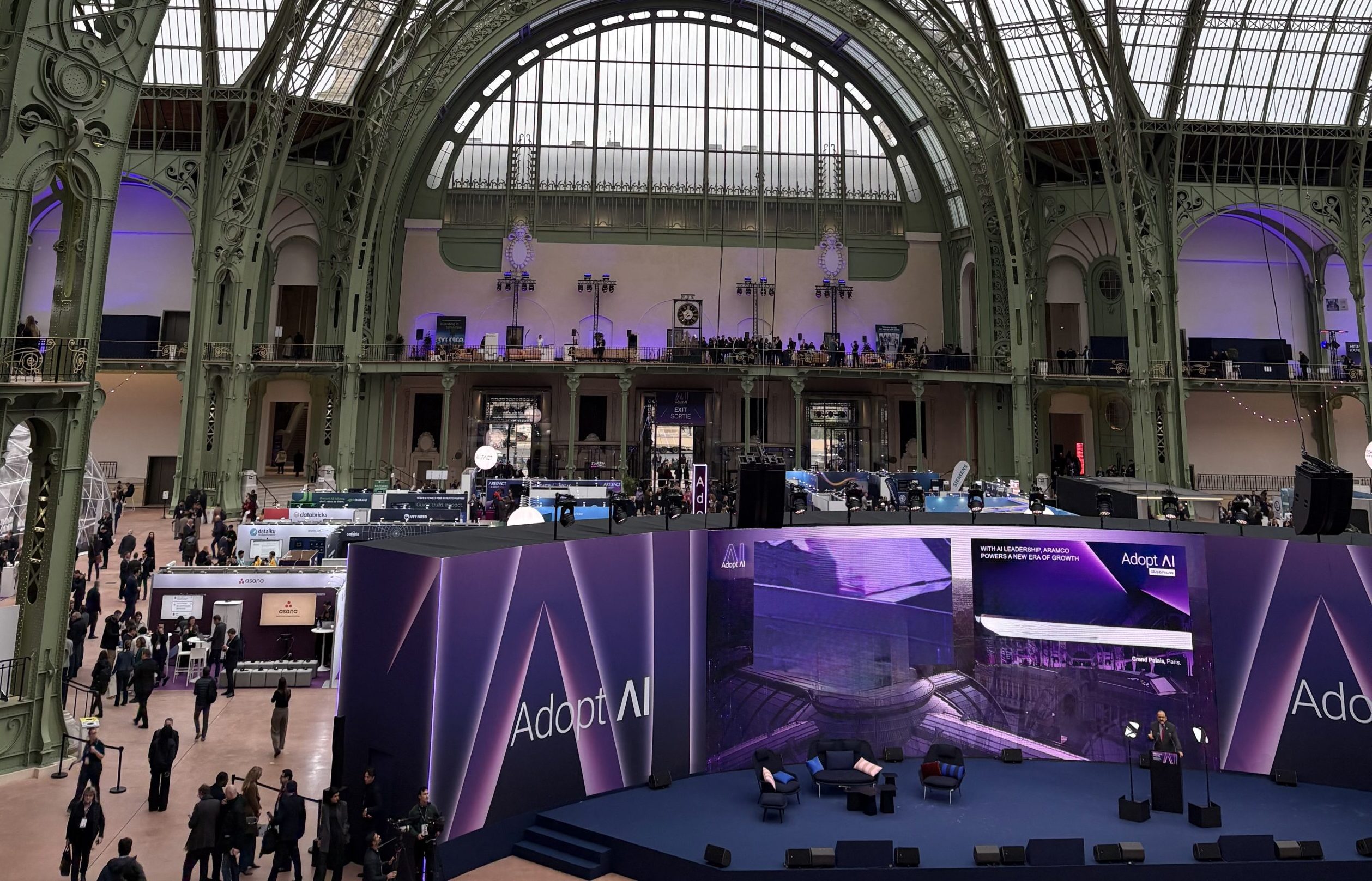
The proposal led by the French national weather service will see a coalition of European partners build the first digital twin awarded in ECMWF’s call for tenders as part of the implementation of the flagship initiative of the European Commission. The on-demand extremes digital twin will build a configurable framework for impact assessment and prediction of weather-induced extremes at sub-kilometre scales.
Through the agreement signed with the European Centre for Medium-Range Weather Forecasts (ECMWF) on 1 September 2022, the French Meteorological Service Météo-France and partners from 22 European countries, will develop a configurable capability for an interactive European monitoring and prediction framework from continental to city scales in response to meteorological, hydrological and air quality extremes.
The future system aims to combine weather, hydrological and air-quality observation and simulation capabilities at a new level of information discovery and data interactivity.
The team led by Météo-France consists of national weather services and other European scientific and environmental institutions. It thus benefits from a strong track record in running 24/7 operational services serving a wide range of communities on large-scale computing systems, as well as running weather and impact models at km and sub-km scales in the framework of the ACCORD consortium for the development of regional-scale numerical weather prediction.

The on-demand capability proposed by the Météo-France led partnership is a key component of the weather-induced extremes digital twin, which is one of the two high-priority digital twins ECMWF will deliver in the first phase of Destination Earth (DestinE). It complements the global continuous component of this digital twin, which is developed at ECMWF using the Integrated Forecasting System.
The project meets the demanding scientific and technological requirements of the tender and presents a solid roadmap for new, configurable on-demand capabilities of an impact driven extremes digital twin. The first demonstration will be delivered by the end of the first phase of DestinE in April 2024.
Unprecedented configurable on-demand prediction capabilities at very high resolution
The on-demand extremes digital twin aims to provide short-range predictions with a resolution between 500 and 750 metres and even 200 metres for particular cases, building on the previous experiences with km-scale limited-area weather prediction systems in the framework of the ACCORD consortium. “What is in my view even more exciting than this increased horizontal resolution to sub-km scales is that the on-demand extremes digital twin will develop flexible and scalable workflows for the monitoring and short-range prediction of extremes”, says Irina Sandu, Science Lead for DestinE at ECMWF.
These prediction capabilities will be configurable in order to enhance both performance and sectoral information content. For example, algorithms will be developed to automatically select a geographical domain, its size, spatial resolution and tailored methodology, to introduce an event and extremes-type focus linked to impact sector specific models.
During the first phase, the overall geographical extent of the on-demand extremes digital twin simulations will be limited to Europe.

The ACCORD modelling system code, which will constitute the core of the on-demand extremes digital twin, is fully compatible with ECMWF’s Integrated Forecasting System (IFS). This makes it an ideal starting point to embed the on-demand extremes digital twin in ECMWF’s digital twin engine, which provides the software infrastructure for workflows, data handling and machine learning. In the context of the on-demand extremes digital twin, Météo-France and its partners will adapt their workflows and codes to be able to run and be interoperable on the EuroHPC computing facilities.

Co-design with impact sectors
Another strength of Météo-France’s led proposal is an ambitious strategy of co-design and demonstration of the added value of the on-demand extremes digital twin for dealing with the impact of extreme events for three impact sectors: air quality, hydrology and renewable energy. As part of this effort, one hydrological and two air quality models will be embedded in the digital twin through a one-way coupling approach allowing the impact models to always make direct use of the full Earth-system information.
Météo-France and its partners will explore the added value of the high-resolution predictions for extremes hydrological events for flood prediction and mitigation actions with an initial focus on nine case studies across Europe that are representing the variety of atmospheric and geographical conditions of the continent. The on-demand extremes digital twin will also explore the added value of sub-km resolutions for simulating hazardous air quality situations, by using an ensemble of air quality models. The renewable energy use cases will use the meteorological data from the high-resolution on-demand digital twin simulations as input and data provided by European Transmission System Operators (TSO’s) and will focus on cases where the traditional weather forecasts have been unable to anticipate events with an impact on energy production such as large thunderstorms or fog.
DestinE On-Demand Extremes (DE_330_MF) digital twin map of partner countries
Participant Countries and agencies
Above: DestinE On-Demand Extremes (DE_330_MF) digital twin map of partner countries: Participant countries and agencies. Yellow: Countries with another agency involved in addition to the National Hydro-Meteorological Service. Otherwise Blue when only the NHMS is a partner. Source: Meteo-France.
European cooperation at its best
Météo-France sets out the large cooperation proposal for the on-demand extremes digital twin in the context of the tradition of cooperation of the European meteorological services and with the scientific community. Météo-France has invited 21 other European national meteorological agencies involved in the ACCORD consortium as subcontractors. Seven other European scientific and environmental institutions provide their expertise in other fields, for example supercomputing, including the Barcelona Supercomputing Centre (BSC) and Finland’s CSC HPC, who will support the implementation of the on-demand extremes digital twin in the EuroHPC environment.
Among the major scientific and technological challenges, the on-demand Digital Twin partnership aims at designing hyper-resolution configurations of the ACCORD-based Numerical Weather Prediction models, AROME, HARMONIE-AROME and ALARO as possible choices. The teams will work on porting code components on EuroHPC computing platforms and in this field Destination Earth is expected to act as an accelerator for the adaptation of current model codes to novel HPC architectures.
The management and scientific leadership will be largely shared internationally, with a main leadership ensured by staff from Météo-France, and science and technology leads from Met Norway and DMI (Denmark).
Destination Earth is ramping up
With the signature of the contract for the on-demand Extremes digital twin, ECMWF achieves an important milestone of its contribution to Destination Earth, the ambitious European Union initiative to create a highly accurate digital twin of the Earth system to better anticipate and predict the impacts of extremes and climate change supporting adaptation and decision making. The digital twin will complement and provide future capabilities for existing services, provided by the National Meteorological and Hydrological Services and Copernicus.
The contract for the second high-priority digital twin on climate change adaptation is currently under negotiation, and the winning bid will be announced shortly. The calls for tenders for Use Cases and Visualization and new data immersion technologies are under evaluation.
In the last six months since Destination Earth has been officially launched by the European Commission, ECMWF has been building up a strong team for establishing the core science, technology, administration and communication aspects of its involvement in the initiative, and is also preparing a strategy for wide ranging scientific and technological partnerships together with its partner entities ESA and EUMETSAT.
Further reading:
ECMWF Destination Earth webpage
Shaping Europe’s Digital Future
Destination Earth is a European Union funded initiative launched in 2022, with the aim to build a digital replica of the Earth system by 2030. The initiative is being jointly implemented by three entrusted entities: the European Centre for Medium-Range Weather Forecasts (ECMWF) responsible for the creation of the first two ‘digital twins’ and the ‘Digital Twin Engine’, the European Space Agency (ESA) responsible for building the ‘Core Service Platform’, and the European Organisation for the Exploitation of Meteorological Satellites (EUMETSAT), responsible for the creation of the ‘Data Lake’.
We acknowledge the EuroHPC Joint Undertaking for awarding this project strategic access to the EuroHPC supercomputers LUMI, hosted by CSC (Finland) and the LUMI consortium, Marenostrum5, hosted by BSC (Spain) Leonardo, hosted by Cineca (Italy) and MeluXina, hosted by LuxProvide (Luxembourg) through a EuroHPC Special Access call.
More information about Destination Earth is on the Destination Earth website and the EU Commission website.
For more information about ECMWF’s role visit ecmwf.int/DestinE
For any questions related to the role of ECMWF in Destination Earth, please use the following email links:


